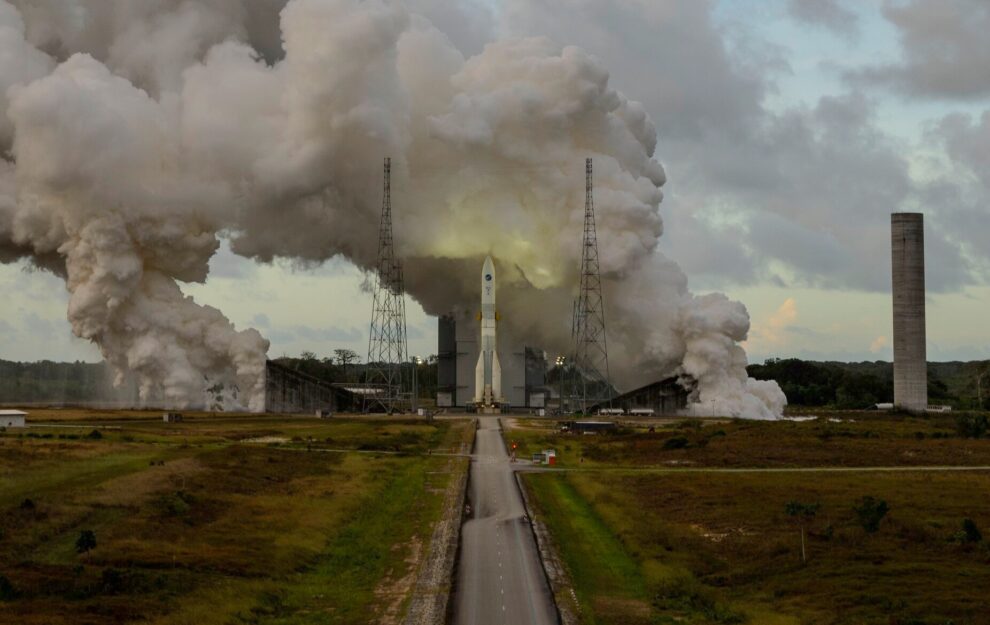With the successful completion of a core stage hot-fire test, the European Space Agency says it now expects the first launch of the Ariane 6 to take place in the middle of 2024.
At a Nov. 30 briefing, ESA Director General Josef Aschbacher announced a launch period for the inaugural Ariane 6 flight of June 15 through July 31. A more precise launch date will be provided after qualification reviews in the spring of 2024.
The announcement comes after a Nov. 23 long-duration test firing of a model of the core stage of the Ariane 6. That test, conducted on the launch pad at Kourou, French Guiana, was intended to simulate a full burn by the core stage.
“It became pretty clear right after the test that this was going very well,” Aschbacher said, a conclusion affirmed at a meeting of an Ariane 6 task force Nov. 29, allowing ESA to set a launch date. “We are very confident that the test was a full success.”
During that test, the core stage’s Vulcain 2.1 engine was intended to fire for 470 seconds. However, the engine shut down after 426 seconds, which officials attributed to a faulty sensor and “very conservative” test thresholds intended to protect the launch pad that would not have been used on an actual launch.
“All the objectives for the test were anyway achieved,” said Toni Tolker-Nielsen, ESA’s director of space transportation. “It didn’t change the success of the test.”
The core stage test took place after a Sept. 1 test of the Ariane 6 upper stage in Germany, which confirmed its performance in a nominal flight. “We’ve got all the hot-fire tests which are needed for the qualification of the maiden flight,” said Martin Sion, chief executive of ArianeGroup, the prime contractor for the Ariane 6.
There are still some additional tests planned before the first launch. Another upper stage test is scheduled for Dec. 7 in Germany to test its performance in “degraded” conditions. A fueling test of the Ariane 6 in Kourou is scheduled for Dec. 15, which will conclude with a brief ignition of the core stage engine.
Flight hardware for the first Ariane 6 launch, called FM1, will be transported by ship from Europe to French Guiana, arriving in February. It will undergo final tests there, including a wet dress rehearsal, Sion said.
The first launch will carry several small satellites. “It’s not bringing a major payload into space,” Aschbacher said, but noted the agency wanted to still use the flight as an opportunity for smaller satellites.
If the first launch is successful, ESA and Arianespace will work towards a second launch before the end of 2024. “The target is to have a second flight by the end of the year,” said Stéphane Israël, chief executive of Arianespace. “This is a key target for us.” That second launch, he later said, would carry the CSO-3 reconnaissance satellite for the French military.
He said that Arianespace will seek to conduct “as many flights as possible” in 2025, including the first launches for its largest commercial customer, Amazon’s Project Kuiper constellation. The long-term goal is 9 to 10 Ariane 6 launches per year.
Aschbacher said the test, along with an agreement on future support for the Ariane 6 reached at the European Space Summit in Seville, Spain, Nov. 6, marked the beginning of the end of a “launcher crisis” that has temporarily deprived Europe of independent access to space. That crisis, caused by Ariane 6 delays as well as the grounding of the Vega C after a December 2022 launch failure, has required ESA and the European Commission to turn to SpaceX for launches of key science and navigation satellites.
“One should not underestimate the decisions of Seville,” he said, where ESA members agreed to provide up to 340 million euros ($370 million) a year in support for the Ariane 6, authorizing the purchase of a tranche of 27 rockets after the initial group of 15. The agreement also included support at lower levels for Vega C. “To have this access to space guaranteed now throughout the decade, both for the Ariane 6 and the Vega C launchers, is fundamental.”
“It is really fundamental that we regain our foothold on the launcher landscape,” he said at the end of the briefing. “But, of course, we have yet to perform.”
Source: Space News










